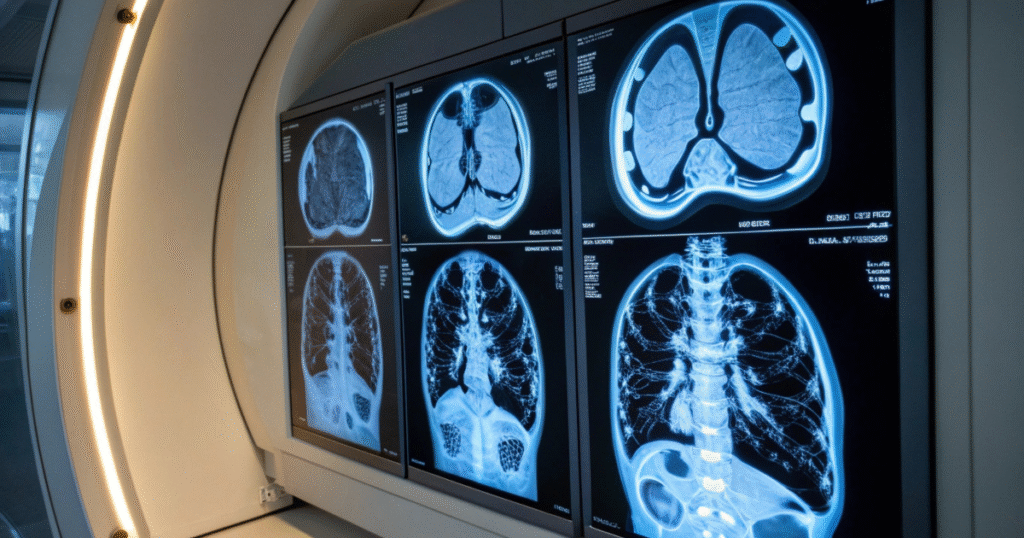AI medical imaging is entering a new phase of adoption, expanding well beyond radiology into wound care, oncology, cardiovascular diagnostics, emergency medicine, and real time clinical decision support. Hospitals are transitioning from traditional visual assessment toward imaging systems that capture deeper spectral data, analyze patterns at scale, and provide predictive insights no clinician could detect alone. This shift is becoming one of the most powerful forces reshaping modern healthcare.
TL;DR
- AI medical imaging is moving beyond radiology into nearly every clinical department.
- Multispectral imaging and deep learning enable earlier and more accurate decision making.
- Hospitals benefit from faster triage, more consistent assessments, and reduced costs.
- The healthcare automation market is expected to reach more than one hundred billion dollars.
- AI powered imaging devices already represent most FDA approved medical AI tools.
The Evolution of AI Medical Imaging
For decades, medical imaging innovation centered around hardware improvements: higher resolution MRI machines, better CT scanners, and safer ultrasound systems. The breakthrough of the last five years has been software. AI now interprets images across modalities, detects subtle patterns, and identifies early signs of disease long before visible markers appear.
Radiology was the first department transformed, with hundreds of FDA cleared AI tools targeting lung nodules, fractures, stroke detection, and tumor characterization. But the impact is now expanding into broader clinical domains:
- Wound care: Multispectral imaging technologies can evaluate tissue viability and healing potential.
- Oncology: AI driven pattern recognition enhances cancer detection and treatment response modeling.
- Cardiology: Algorithms analyze cardiac imaging, perfusion, and vascular scans in near real time.
- Emergency medicine: Rapid interpretation tools support stroke, trauma, and pulmonary cases.
AI medical imaging is no longer an isolated workflow. It is becoming foundational infrastructure inside hospitals.
Multispectral AI Medical Imaging: A New Layer of Insight
One of the fastest growing categories in imaging is multispectral and hyperspectral imaging. These modalities capture data across numerous wavelengths of the electromagnetic spectrum, revealing biochemical and structural information invisible to standard imaging.
This approach allows clinicians to understand:
- Oxygenation levels
- Tissue viability
- Inflammation patterns
- Subtle changes in healing or deterioration
- Underlying damage not visible at the surface
Companies such as Spectral AI, Lunit, and emerging hyperspectral imaging startups are demonstrating how this technology can apply across burn care, oncology, dermatology, and chronic disease management.
The power of multispectral imaging comes from combining hardware with large clinical datasets. One AI model, DeepView, has been trained on more than two hundred billion wound related data points. Other models in oncology and neurovascular imaging have processed tens of millions of scans. As datasets grow, predictive accuracy continues to improve.
Why Hospitals Are Accelerating Adoption
Hospitals face three simultaneous pressures:
Rising patient volume, limited specialist availability, and the need for more consistent clinical assessments. AI medical imaging sits at the intersection of those challenges.
Key benefits driving adoption
1. Faster decision making
AI can interpret images instantly, reducing bottlenecks and accelerating triage.
2. Greater diagnostic accuracy
Algorithms detect patterns beyond the limits of human perception.
3. Reduced costs
Studies project that AI could save the US healthcare system more than two hundred billion dollars each year.
4. Workforce extension
Smaller hospitals gain access to the diagnostic capabilities of larger systems.
5. Better patient outcomes
Earlier detection leads to more effective treatment, reducing complications and readmissions.
The result is a shift from reactive imaging toward proactive, predictive insights.
The Broader Market Landscape in AI medical imaging
Medical imaging remains one of the fastest growing sectors in healthcare automation. The global automation market is projected to exceed one hundred billion dollars by 2033 as hospitals invest in intelligent diagnostics, workflow platforms, and advanced imaging systems.
AI medical imaging is also the largest category within the FDA’s approved AI device portfolio. More than seven hundred out of the nine hundred fifty cleared AI tools are imaging related. This reflects the alignment between imaging and machine learning: high data volume, clear labels, and consistent clinical workflows.
Examples of innovation across the sector
Lunit
A global imaging company improving cancer detection and early screening. It expanded its portfolio by acquiring breast imaging provider Volpara in a deal valued at nearly two hundred million dollars.
RapidAI
A neurovascular and vascular imaging platform used in more than two thousand hospitals. It has analyzed over twenty million scans to support stroke and trauma care.
Spectral AI
A leader in multispectral wound imaging, contributing to the expansion of AI into previously low tech clinical fields.
These examples represent a broader wave of companies building tools that integrate into daily hospital operations.
Challenges Ahead for AI Medical Imaging
While momentum is strong, hospitals still face barriers that slow adoption.
Workflow integration
AI must fit into existing imaging systems, EHRs, and clinical protocols.
Interpretability
Clinicians need confidence in why models make certain predictions.
Regulation and validation
Medical AI requires extensive testing, certification, and ongoing monitoring.
Data standardization
Differences in imaging hardware and clinical documentation can reduce model performance.
Cultural acceptance
For many clinicians, AI must prove its value repeatedly before it becomes a trusted tool.
Overcoming these challenges will determine which innovations become standard in hospitals over the next decade.
FAQs
What is AI medical imaging?
AI medical imaging uses machine learning models to analyze medical scans and assist in diagnostic decision making.
Is multispectral imaging widely used?
Adoption is growing. Hospitals are beginning to use it in wound care, oncology, dermatology, and surgical planning.
Does AI replace radiologists or specialists?
No. AI augments clinicians by providing faster interpretation and deeper insight.
Why is imaging the biggest AI category?
Imaging generates large volumes of structured data, making it ideal for machine learning.
What is driving growth in this market?
Increasing patient volume, cost pressure, and the push for earlier and more accurate diagnostics.
Conclusion
AI medical imaging is entering a new phase where software, spectral data, and predictive models redefine how hospitals diagnose, triage, and monitor patients. Radiology may have been the first frontier, but the next wave includes wound care, oncology, cardiology, emergency medicine, and beyond. As imaging becomes more intelligent, clinicians gain a clearer, deeper understanding of patient health, leading to faster decisions, better outcomes, and more efficient use of hospital resources.
The future of diagnostic care will be defined not only by what clinicians can see, but by what AI can reveal.
Related content you might also like:
- Healthcare Innovation Trends in Technology & Policy
- The Rise of AI-Generated Brand Ambassadors
- The Future of Healthcare: Embracing the Shift from Digitization to ‘Data’fication


